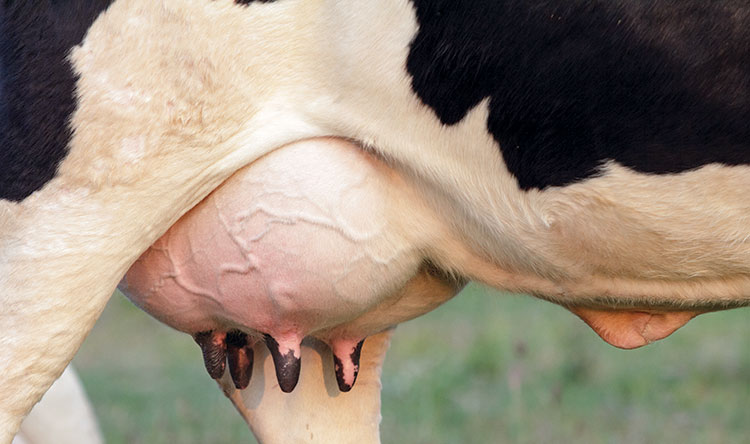
The 59th annual meeting of the National Mastitis Council (NMC) was held in late January. I, once again, was extremely impressed by the international “think tank” of attendees who hailed from 45 countries around the globe. Very fittingly, NMC’s motto is: The global organization for mastitis control and milk quality.
Attendees were immensely diverse in age and occupation. We continually learn from each other, and lasting friendships are always formed at NMC. I would like to share with you a few things from the meeting that I have been pondering.
More environmental mastitis
Bulk tank somatic cell count (SCC), one measure of milk quality, has continued to make a downward trend in the U.S., as well as other dairy regions globally. Jason Lombard, D.V.M., (USDA, APHIS) reported that in the U.S. milk supply, the milk weighted geometric mean bulk tank SCC averaged 172,000 cells per milliliter (mL) in 2018, a reduction of 42% from 295,000 cells per mL in 1995. Nearly two-thirds of all milk in the U.S. had bulk tank somatic cell counts (BTSCCs) less than 200,000 cells per mL in 2018. This is awesome!
Effective control measures, especially for contagious mastitis, have worked well on most farms. Staph. aureas, Strep. ag, and to a lesser degree, Mycoplasma bovis, have taken a back seat to current environmental infections.
On the flip side, Lombard reported that during this same time period (1996 to 2014), prevalence of clinical mastitis rose from 13% to 24.8%. Perhaps we are monitoring for abnormal milk to a higher degree? Bulk tank SCCs don’t always give us a clear mastitis picture.
Culling clinical mastitis cows and chronic mammary infections has changed substantially over the last decade. Many of our herds today are comprised of 40% or more first lactation animals. These young animals typically, but not always, have lower SCCs.
So, the question becomes, how can we effectively control our current mastitis pathogens? As always, prevention rules the day. A cow gets mastitis four ways: left front (LF), right front (RF), left rear (LR), or right rear (RR) quarters. The environmental bacteria enter via the teat canal; it is that simple.
Keep the stalls clean
Over my years in practice, I have shadowed some great dairy folks who set the bar high in regard to controlling environmental mastitis. Common areas of excellence include diligent attention to clean, deep stall beds. In Michigan, the gold standard is virgin sand. Not that other deep, dry beds won’t suffice, but if we really choose to provide 13-plus hours lying in comfort, with minimal bacterial challenges . . . it’s just hard to beat!
Another area of high importance includes the calving pens. Are they spacious enough? Clean enough?
Certainly, the two or three trips to and from the parlor are focus areas to hone in on. Clean, dry well-stimulated teats provide tremendous advantages for a rapid and complete milkout with minimal hiccups. Many of my clients understand the importance of great teat ends. This is where the natural germ warfare takes place.
At our regional dairy banquets, the same farms receive, year after year, the quality awards. They all share a passion for clean cows, clean stall beds, and clean milking protocols.
Less antibiotic use
In the U.S. dairy community, the practice of selective dry cow therapy (DCT) has been gaining interest in recent years. Once considered a mandatory management step (NMC’s Five Point Plan), the folks from around the globe informed the group that no longer is it deemed necessary to blanket treat all cows with intramammary antibiotics.
I was taught many years ago the role of DCT was to treat current infections, along with preventing new infections, during the critical early dry period. As we have been entering a new era of antimicrobial stewardship, the shift is detection of end of lactation infections.
Several presentations cited data to support selective DCT success. Infection status was either quarter-level culture based or SCC algorithms applied. This practice is now common in many areas of the world. Our “tool box” for effective mastitis control will continue to evolve.
On a similar note, the selection of clinical cases to attempt to treat with antibiotic therapy should be based on science rather than tradition. Culture-based selection criteria would eliminate antimicrobial treatments in roughly two-thirds of clinical cases (those that are no growth or gram negative bacteria). Many of our most successful dairies no longer use lactating antibiotic tubes, but they are diligent in reducing exposure.
In summary, U.S. and global milk quality is continuing to improve. NMC’s current “10 Point Plan” provides areas of management action that have served the dairy industry well.
You and your farm’s “culture of excellence” in regard to providing tremendous dairy products to your consumers will be a huge motivation to those involved on your team. We are entering a new chapter in how we effectively control mastitis. It all starts with prevention.
Folks, the days are getting longer, a little more balmy, and certainly more muddy. But, they are all the rights of this great season coming upon us. Give thanks for it and for all the blessings we’ve been given.









